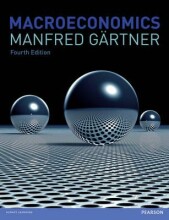Summary: Macroeconomics Canadian Edition | 9781319120085 | Paul Krugman
- This + 400k other summaries
- A unique study and practice tool
- Never study anything twice again
- Get the grades you hope for
- 100% sure, 100% understanding
Read the summary and the most important questions on Macroeconomics Canadian Edition | 9781319120085 | Paul Krugman
-
11 Income and Expenditure
This is a preview. There are 3 more flashcards available for chapter 11
Show more cards here -
What are the assumptions of the multiplier on consumer spending
- Producers are willing to supply
output at a fixed price - interest rates is given
- no government
spending and no taxes exports andimports are zero
- Producers are willing to supply
-
What do we mean for business and consumers spending an additional dollar when we say producers willing to supply additional output at a fixed price
Whenconsumers orbusinesses buying investment goods decide to spend an additional dollar, it will translate into the production of an additionalvalue of goods and services withoutinflation , or a rise in theoverall price. -
What will happen to changes in aggregate expenditure as a result of the supply of additional output being fixed
As a result, of the supply of additional output being fixed changes in aggregate expenditure translate into changes in aggregate output, as measured by real GDP. -
What is the reason that the total real GDP is limited to a number even if income increases, why dont we spend all the money, why is there decreasing returns to scale in spending when the is increase in income?
- That is because at each stage of
expansion , asdisposable income rises so of the income getsleaked out because it is saved.
- That is because at each stage of
-
How much of an addtional income dollar of disposable income is saves depends what? And what is that?
The Marginal propensity to save MPS -
What leads to a rise in consumer spending and a rise in real GDP (wealth effect)?
An increase inasset prices makes owners feelricher therefore the spend more. -
What does self governing mean in the context of autonomous change in expenditure? And what is autonomous change in expenditure?
- it means that the rise in consumer spending is the cause of the rise in real GDP not that effect not the result of it.
- the initial rise in consumption occurs first and then it is followed by the rise in real GDP.
-
What is the importance of multiplier effect? what does the size of the multiplier depend on? And why? Formula?
- we use it to determines how large each round of expansion is compared to the previous round, by applying the size of the
MPC todetermin that ratio - It is the ratio of the total change in real
GSP caused by an autonomous change in aggregate expenditure - the size of the
multiplier depends on the autonomous change in aggregate expenditure.
multiplier = change in Y/change in AE = 1/(1-MPC )
- Y is real GDP, AE
autonoumous expenditure.
- we use it to determines how large each round of expansion is compared to the previous round, by applying the size of the
-
What determines how much saving occurs
The higher the MPC the higher less disposable income leaks out into savings. -
In what situations do the formula for the multiplier change?
When taxes and foreign trade is introduced.
- Higher grades + faster learning
- Never study anything twice
- 100% sure, 100% understanding
Topics related to Summary: Macroeconomics Canadian Edition
-
Income and Expenditure - Consumer Spending - Current Disposable Income and Consumer Spending
-
Income and Expenditure - Consumer Spending - Shifts of the Aggregate Consumption Function
-
Income and Expenditure - Investment Spending
-
Income and Expenditure - The Income–Expenditure Model - Planned Aggregate Expenditure and Real GDP
-
Income and Expenditure - The Income–Expenditure Model - Income–Expenditure Equilibrium
-
Income and Expenditure - The Income–Expenditure Model - The Multiplier Process and Inventory Adjustment
-
Income and Expenditure - The Income–Expenditure Model - What About Exports and Imports?
-
Aggregate Demand and Aggregate Supply - Aggregate Demand
-
Aggregate Demand and Aggregate Supply - Aggregate Supply
-
Aggregate Demand and Aggregate Supply - The AD-AS Model
-
Aggregate Demand and Aggregate Supply - Macroeconomic Policy
-
Money, Banking and the central Banking system
-
Monetary Policy - the demand for money - the opportunity cost of holding money
-
Monetary Policy - the demand for money - the money demand curve
-
Monetary Policy - the demand for money - shifts of the money demand curve
-
Monetary Policy - Money and interest rates - the equilibrium interest rates
-
Monetary Policy - Money and interest rates - monetary policy and interest rate
-
Monetary Policy - Monetary Policy and Aggregate demand - monetary policy in practice
-
Monetary Policy - Monetary Policy and Aggregate demand - inflation targeting
-
Monetary Policy - Monetary Policy and Aggregate demand - the zero lower bound problem
-
Monetary Policy - Money output, and Prices in the long run
-
Monetary Policy - ADDITIONAL NOTES - lags
































